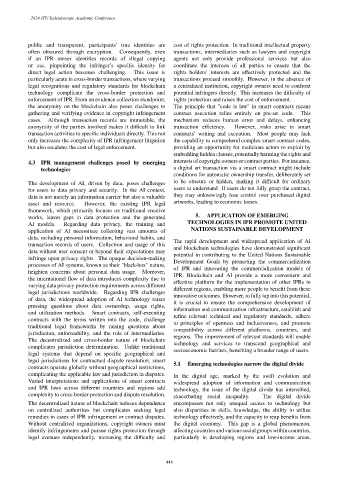Page 492 - Kaleidoscope Academic Conference Proceedings 2024
P. 492
2024 ITU Kaleidoscope Academic Conference
public and transparent, participants’ true identities are cost of rights protection. In traditional intellectual property
often obscured through encryption. Consequently, even transactions, intermediaries such as lawyers and copyright
if an IPR owner identifies records of illegal copying agents not only provide professional services but also
or use, pinpointing the infringer’s specific identity for coordinate the interests of all parties to ensure that the
direct legal action becomes challenging. This issue is rights holders’ interests are effectively protected and the
particularly acute in cross-border transactions, where varying transactions proceed smoothly. However, in the absence of
legal recognitions and regulatory standards for blockchain a centralized institution, copyright owners need to confront
technology complicate the cross-border protection and potential infringers directly. This increases the difficulty of
enforcement of IPR. From an evidence collection standpoint, rights protection and raises the cost of enforcement.
the anonymity on the blockchain also poses challenges to The principle that "code is law" in smart contracts means
gathering and verifying evidence in copyright infringement contract execution relies entirely on pre-set code. This
cases. Although transaction records are immutable, the mechanism reduces human error and delays, enhancing
anonymity of the parties involved makes it difficult to link transaction efficiency. However, risks arise in smart
transaction activities to specific individuals directly. This not contracts’ writing and execution. Most people may lack
only increases the complexity of IPR infringement litigation the capability to comprehend complex smart contract codes,
but also escalates the cost of legal enforcement. providing an opportunity for malicious actors to exploit by
embedding hidden clauses, potentially harming the rights and
4.3 IPR management challenges posed by emerging interests of copyright owners or contract parties. For instance,
technologies a digital art transaction via a smart contract might include
conditions for automatic ownership transfer, deliberately set
to be obscure or hidden, making it difficult for ordinary
The development of AI, driven by data, poses challenges
users to understand. If users do not fully grasp the contract,
for users to data privacy and security. In the AI context,
they may unknowingly lose control over purchased digital
data is not merely an information carrier but also a valuable
artworks, leading to economic losses.
asset and resource. However, the existing IPR legal
framework, which primarily focuses on traditional creative
works, leaves gaps in data protection and the generated 5. APPLICATION OF EMERGING
AI models. Regarding data privacy, the training and TECHNOLOGIES IN IPR PROMOTE UNITED
application of AI necessitate collecting vast amounts of NATIONS SUSTAINABLE DEVELOPMENT
data, including personal information, behavioral habits, and
The rapid development and widespread application of AI
transaction records of users. Collection and usage of this
and blockchain technologies have demonstrated significant
data without user consent or beyond their expectations may
potential in contributing to the United Nations Sustainable
infringe upon privacy rights. The opaque decision-making
Development Goals by promoting the commercialization
processes of AI systems, known as their "black-box" nature,
of IPR and innovating the commercialization models of
heighten concerns about personal data usage. Moreover,
IPR. Blockchain and AI provide a more convenient and
the international flow of data introduces complexity due to
effective platform for the implementation of other IPRs in
varying data privacy protection requirements across different
different regions, enabling more people to benefit from these
legal jurisdictions worldwide. Regarding IPR challenges
innovative outcomes. However, to fully tap into this potential,
of data, the widespread adoption of AI technology raises
it is crucial to ensure the comprehensive development of
pressing questions about data ownership, usage rights,
information and communication infrastructure, establish and
and utilization methods. Smart contracts, self-executing
refine relevant technical and regulatory standards, adhere
contracts with the terms written into the code, challenge
to principles of openness and inclusiveness, and promote
traditional legal frameworks by raising questions about
compatibility across different platforms, countries, and
jurisdiction, enforceability, and the role of intermediaries.
regions. The improvement of relevant standards will enable
The decentralized and cross-border nature of blockchain
technology and services to transcend geographical and
complicates jurisdiction determination. Unlike traditional
socioeconomic barriers, benefiting a broader range of users.
legal systems that depend on specific geographical and
legal jurisdictions for contractual dispute resolution, smart
5.1 Emerging technologies narrow the digital divide
contracts operate globally without geographical restrictions,
complicating the applicable law and jurisdiction in disputes. In the digital age, marked by the swift evolution and
Varied interpretations and applications of smart contracts widespread adoption of information and communication
and IPR laws across different countries and regions add technology, the issue of the digital divide has intensified,
complexity to cross-border protection and dispute resolution. exacerbating social inequality. The digital divide
The decentralized nature of blockchain reduces dependence encompasses not only unequal access to technology but
on centralized authorities but complicates seeking legal also disparities in skills, knowledge, the ability to utilize
remedies in cases of IPR infringement or contract disputes. technology effectively, and the capacity to reap benefits from
Without centralized organizations, copyright owners must the digital economy. This gap is a global phenomenon,
identify infringements and pursue rights protection through affectingcountries andvarious socialgroups within countries,
legal avenues independently, increasing the difficulty and particularly in developing regions and low-income areas,
– 448 –

